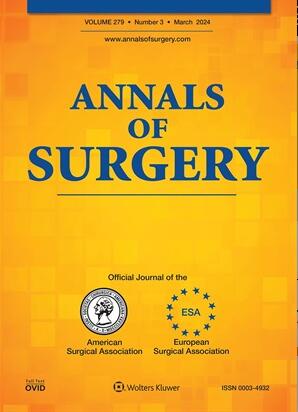Defining Biological Borderline Resectable Non-Functioning Pancreatic Neuroendocrine Tumors (NF-PanNETs): A Predictive Model for Preoperative Assessment of Early Recurrence Risk.
IF 6.4
1区 医学
Q1 SURGERY
引用次数: 0
Abstract
OBJECTIVE This study aimed to develop and validate a preoperative predictive model to identify patients at high risk of early recurrence (ER), with a view to establish a framework for biological borderline resectability of non-functioning pancreatic neuroendocrine tumors (NF-PanNETs). SUMMARY BACKGROUND DATA Radical surgery is curative for most localized NF-PanNETs, but a subset of patients experiences ER. No standardized criteria define preoperative high-risk disease. METHODS A retrospective multicentric study was conducted at three tertiary centers. Patients undergoing curative resection for localized NF-PanNETs were included, and preoperative clinicopathological and imaging variables were analyzed. ER was defined as a recurrence within 24 months. A classification tree model was developed, and performance was assessed using the AUC of the ROC curve. RESULTS A total of 496 patients were analyzed, with 290 in the derivation cohort and 206 in the validation cohort. ER occurred in 55 patients (11%), including 26 (9%) in the derivation and 29 (14%) in the validation cohort. The median disease-free survival for ER patients was 16 months (IQR: 10-20 months). Neoplastic venous thrombosis was the strongest predictor of ER, with an ER probability of 71%. Among patients without venous thrombosis, those with a Ki-67 index ≥5% and tumor size ≥3 cm had an ER probability of 41% in case of adenopathy and 19% otherwise. The model achieved an AUC of 0.91 in the derivation cohort and 0.84 in the validation cohort. CONCLUSIONS This externally validated model provides a reliable preoperative tool to identify NF-PanNETs at high-risk of ER and introduces the concept of biological borderline resectable NF-PanNETs.定义生物学边缘可切除无功能胰腺神经内分泌肿瘤(NF-PanNETs):早期复发风险术前评估的预测模型。
目的:本研究旨在建立并验证一种早期复发高危患者的术前预测模型,以期建立无功能胰腺神经内分泌肿瘤(NF-PanNETs)的生物学边缘可切除性框架。背景:根治性手术可以治愈大多数局限性NF-PanNETs,但一小部分患者会出现ER。没有标准化的标准来定义术前高危疾病。方法在三个三级中心进行回顾性多中心研究。纳入接受根治性切除术的局限性NF-PanNETs患者,并分析术前临床病理和影像学变量。ER定义为24个月内复发。建立了一个分类树模型,并使用ROC曲线的AUC来评估性能。结果共分析496例患者,衍生组290例,验证组206例。55例(11%)患者发生ER,其中衍生组26例(9%),验证组29例(14%)。ER患者的中位无病生存期为16个月(IQR: 10-20个月)。肿瘤静脉血栓形成是ER的最强预测因子,其ER概率为71%。在无静脉血栓形成的患者中,Ki-67指数≥5%、肿瘤大小≥3cm的患者,腺病患者的ER概率为41%,非腺病患者为19%。该模型在衍生队列中的AUC为0.91,在验证队列中的AUC为0.84。结论经外部验证的NF-PanNETs模型为识别ER高危NF-PanNETs提供了一种可靠的术前工具,并引入了生物临界可切除NF-PanNETs的概念。
本文章由计算机程序翻译,如有差异,请以英文原文为准。
求助全文
约1分钟内获得全文
求助全文
来源期刊

Annals of surgery
医学-外科
CiteScore
14.40
自引率
4.40%
发文量
687
审稿时长
4 months
期刊介绍:
The Annals of Surgery is a renowned surgery journal, recognized globally for its extensive scholarly references. It serves as a valuable resource for the international medical community by disseminating knowledge regarding important developments in surgical science and practice. Surgeons regularly turn to the Annals of Surgery to stay updated on innovative practices and techniques. The journal also offers special editorial features such as "Advances in Surgical Technique," offering timely coverage of ongoing clinical issues. Additionally, the journal publishes monthly review articles that address the latest concerns in surgical practice.
 求助内容:
求助内容: 应助结果提醒方式:
应助结果提醒方式:


